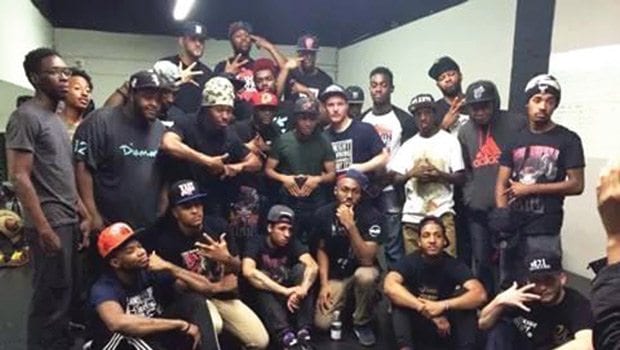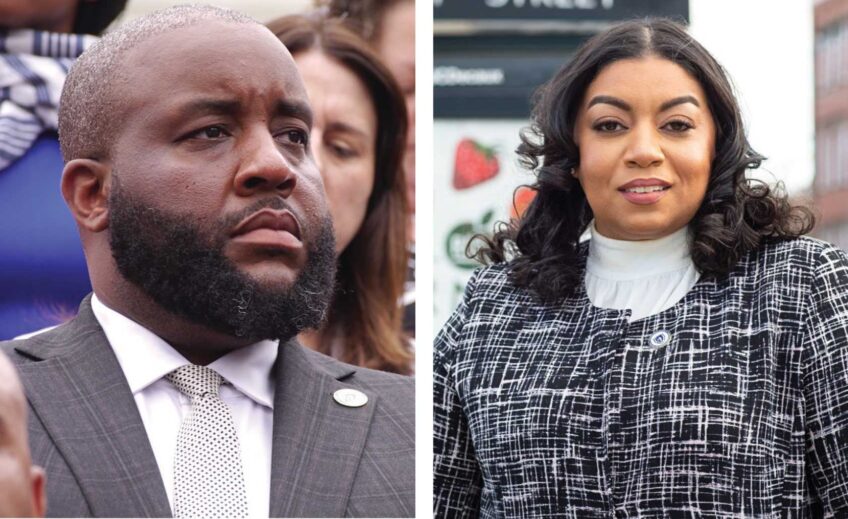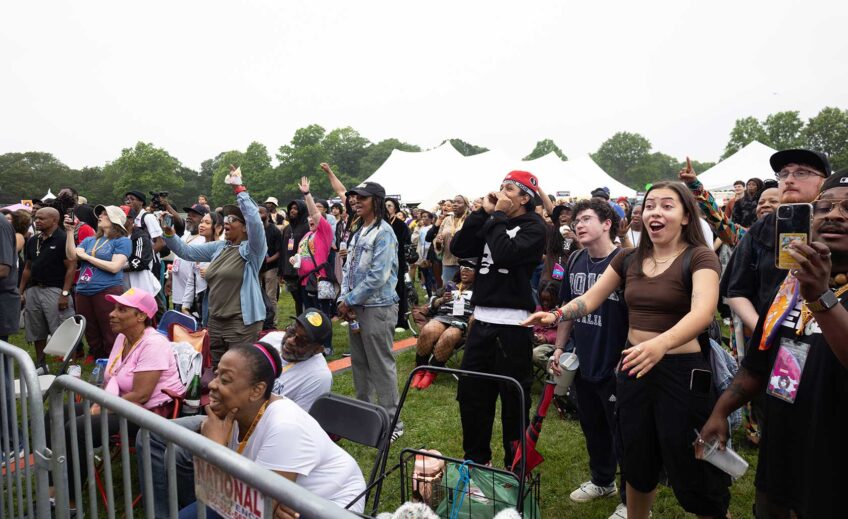
Tayquan Pomare-Taylor wanted a place to fit in, somewhere he could express his bottled-up anger and negativity about the world around him. Struggling to find a place to express himself creatively, Pomare-Taylor stumbled upon krump dancing.
“I felt at home at Krump United,” Pomare-Taylor said.
Krump United is a weekly dance program hosted at the Perkins Community Center in Dorchester. Every Friday between the hours of 6 p.m. and 9 p.m., krumpers from around Boston organize dance battles during these sessions. Krump United expands its reach to other teams around the Northeast, from Rhode Island to Connecticut.
“Krump is deep. It allows me to tell stories,’ Pomare-Taylor said. “The stronger and sharper I move, the more powerful it becomes. I’m a good kid, I don’t get into trouble, but I prefer to be in an environment where I am not judged or feel restricted. I have all this energy, I just want to make better use of it.”
Krump is an urban street dance form characterized by hard, high-energy improvisational moves. It is an aggressive and emotional dance that incorporates stomping, arm swinging and jab movements.
The Krump United program began earlier this summer, in the hopes that youth could learn to express themselves and their struggles through the dance. The program is led by two of its originators, Traiquan Stroud and Adrian Major.
“This program is all about curbing violence,” Major said. “Getting into the understanding that people came in with issues, and we resolve those issues through krump dancing.”
With 74 members and counting, Krump United’s retention rate has been successful through its open-door policies and mission.
“It doesn’t matter what you do, what ethnicity you are or spiritual denomination,” Major said. “There is one ‘U’ in Krump and one ‘U’ in United, and it starts with you, and we are all about progressing collectively.”
Like Pomare-Taylor, other participants agreed that the program increases confidence, builds character, and is a creative alternative to negative behavior and activity. Though Krump United has seen much success in the last few months, the program continues to struggle with community acceptance of the art form.
“Life for me as a black educated dancer is pretty tough,” said Rodney Henry, a Roxbury resident who attends Fenway High School. “Society expects little from us because of my environment. I refuse to be a statistic because of where I live and what I do,” he said. “I have plans to become a lawyer and hopefully be able to open my own insurance company. I love where I come from, but it don’t make me who I am today in society.”
This year, Krump United represented Boston in “Phitted Talks,” a Rhode Island workshop hosted by Thr3e Live Dance Company founders Dennis “Twin Knucklehead” Leggett and Tjay “Twin Basix” Martino, who’s also known as “Wonderbread.” The three-day event attracted hundreds of krumpers from around the East Coast to properly train dancers in the art. The workshops included dance battles by some of the finest krump dancers in the East and the legendary originator of krump, Ceasare “Tight Eyez” Willis.
“These sessions are the most important things about krump,” Leggett said.
The 10-year krump veteran said hosting events such as Phitted Talks gives dancers opportunities not only to hone their skills but to “cultivate relationships” with others.
“In 2014, krumpers are trying to expand more and learn different methods of dance,” he said. “We want to show our community and the hip-hop world that this is a serious movement and we are really great dancers. Even our nicknames are a manifestation of ourselves.”
Leggett believes krump is all about “freedom of expression.” The nicknames are an exaggerated version of who they are, which is portrayed in each individual’s style of dance.
Krump sessions sometimes are organized by various crews or “fams,” which are dance teams that create unique moves according to their specific style. Structurally, these “fams” consist of seasoned dancers who take novice dancers under their wing. One representative from the crew will dance while the rest of the members cheer or “hype” the dancer.
Krump United’s goal to produce events such as Phitted Talks might seem far-fetched, considering the amount of time, dedication and resources to create such platform in Boston, but they believe it all starts with community support.
“This program has certainly drawn more than young people to our community center,” said Troy Smith, director of the Perkins Community Center.
Krump United has attracted a wide range of ages, from 8 all the way to 65.
When Major asked Smith for permission to use the facilities for weekly sessions, Perkins Center staff members were delighted to have the krumpers on board. The Perkins Center provides programs to school-aged children, ranging from basketball to teen-talk programs.
“They came prepared with established ground rules and their willingness to open the doors for anyone in the community interested in learning about their craft,” Smith said. “Even a few of the participants in this program were active members of the community center at a very young age. I couldn’t turn them down.”
Smith said he’s proud to see how much the program has grown. Originally, the group had 25 members and still continues to flourish. Krump United’s growing social media presence helps to keep the community center vibrant on Friday nights. The program utilizes Facebook by posting practice videos, session invitations, and workshops around the area.
“It’s amazing to see the youth come together in a neutral setting, no matter what territorial issues they have outside our center, and just unite in camaraderie through dance,” Smith said. “I would like to see this go viral.”
The Dorchester Youth Collaborative, a community-based youth center in Fields Corner, once was a popular place for krumpers in Boston. The center, which is known for its strong program, believes funding is needed for performing arts in urban communities.
“Low-income urban youth have a bad rap in the community because of negative labels like violence and gangs attached to them, and much of it is undeserved,” said Emmett Folgert, executive director of DYC. “We have just as many artists in places like Dorchester, we don’t have as many easels or opportunities for art, and that’s a shame. Its places like Fields Corner where modern cutting edge culture is created.”
After a successful two-year run of the DYC krump program, retention slowly started to dwindle. As much as the center works to keep youth safe and off the streets, outside influences have made it difficult for the dance program to thrive.
“Krump itself is an alternative way to rebel against this so-called ‘gangster culture,’” said Folgert, who witnessed the gang culture’s influence on youth.
“Right now, what I have to say to the youth at Krump United is to stay focused,” Folgert, said. “Understand why you are krumping. Don’t let outside influences derail you from your purpose. Our DYC community is very collaborative, and if they want to connect, we can make it happen. There is power in numbers.”
In November, Project Hip Hop, a youth-led organization that teaches the use of hip hop as a tool for public education, opened its doors to young artists in its first Critical Lab and Lounge series, which Krump United supported. It was designed to create one safe space for artists to unite and celebrate their creativity.
The lab is sectioned off in different rooms featuring krump sessions, spoken-word artists, writers and visual art galleries.
“This is an inter-generational space for young and seasoned artists to learn best-practices in developing their craft,” said D. Farai Williams, acting executive director of Project Hip Hop.
An important pillar of the Critical Lab series is for artists to understand “political fluency,” or guiding youth to find their purpose in the community and how to properly respond to social issues affecting them.
“Artists experience life closer to the edge, because we are not valued,” Williams said. “Artists have a voice and need to be able to speak out on social issues in this community.”
Williams supports Krump United and respects its dedication to creating a collaborative movement.
“We need more partnerships with programs like Krump United because the city does an injustice to young people, particularly young black and brown people that are in these schools, that are on these streets and are not providing them creative safe space to express themselves through their bodies and voices,” she said.
Krump United plans to partner with high schools to educate students about its program and the dance form. The one thing Major took from his experience starting up the program “is what you put in, is what you get out,” he said.
“The question always is, if you are not supporting others, how do you expect others to support you?” he asked. “That is the only way we can move forward as a community.”






